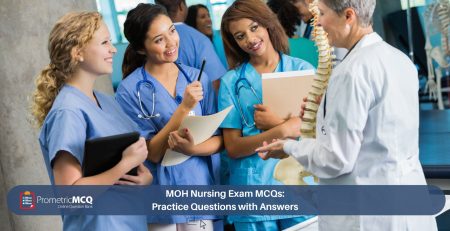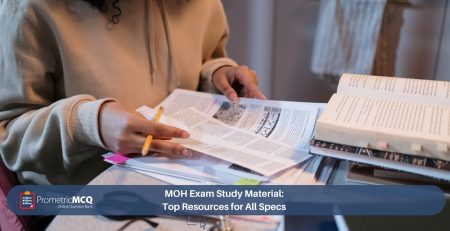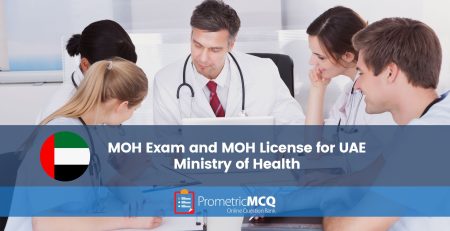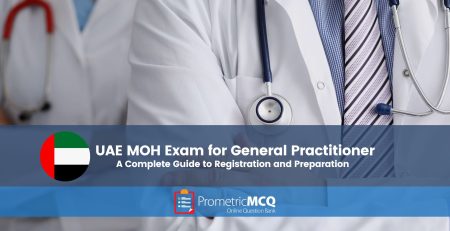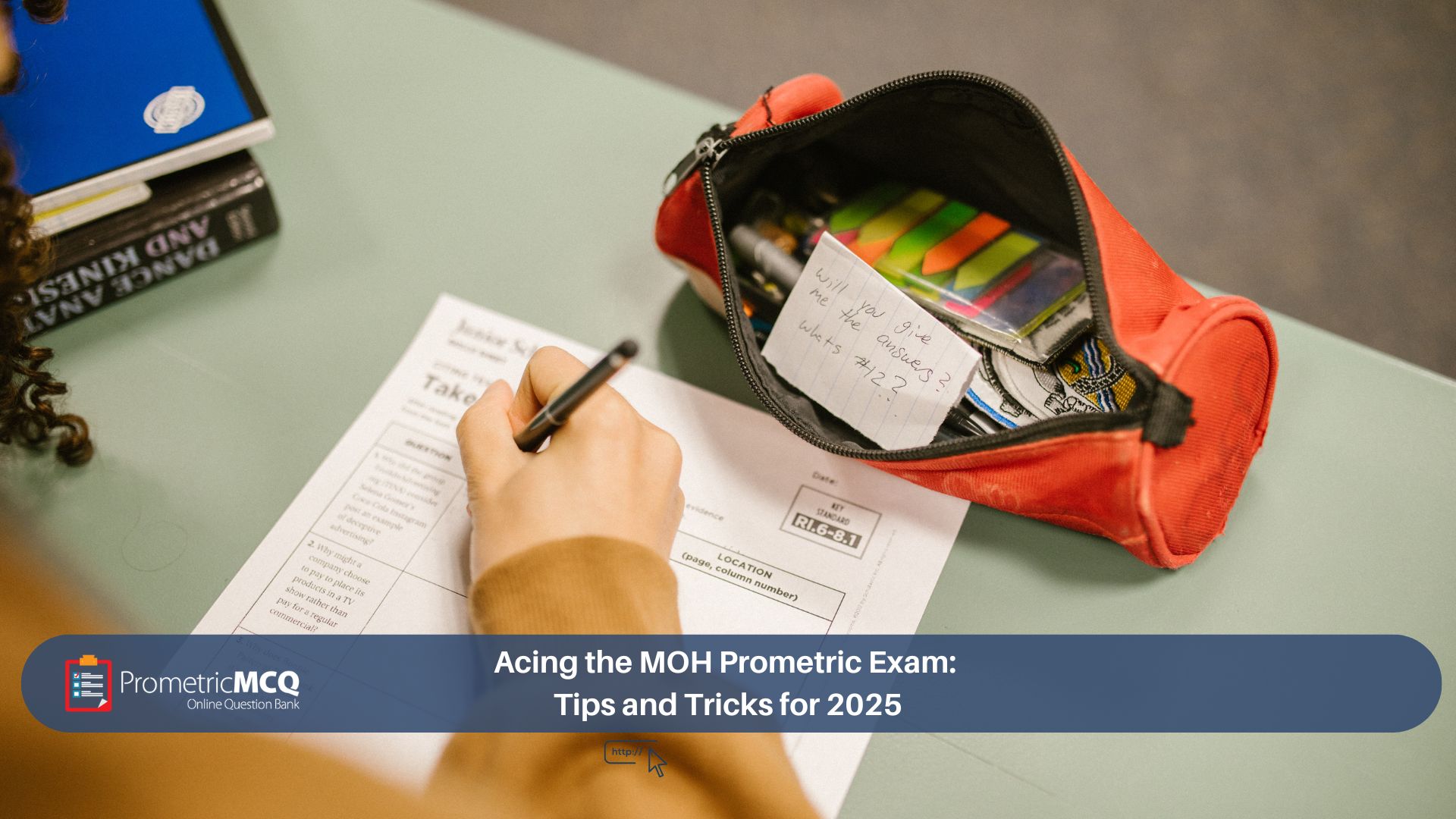
Acing the MOH Prometric Exam: Tips and Tricks for 2025
fatima@prometricmcq.com2025-09-15T14:47:02+00:00Table of Contents
ToggleAcing the MOH Prometric Exam: Tips and Tricks for 2025
For doctors, nurses, pharmacists, and allied health professionals across the globe, the UAE’s Ministry of Health and Prevention (MOHAP) Prometric exam is a pivotal career milestone. It is the official gateway to practicing your profession in a dynamic and rapidly advancing healthcare sector. However, the exam’s reputation for being challenging can be a source of considerable stress. The key to transforming this anxiety into confidence lies in a simple truth: the exam is not designed to trick you, but to ensure you meet a high standard of clinical competence.
Acing the MOH exam is less about superhuman memory and more about superior strategy. Success is built on a foundation of smart, efficient, and targeted preparation. It involves understanding the psychology of the exam, mastering the art of MCQ deconstruction, and adopting a disciplined study plan that prioritizes high-yield concepts. Forget disorganized, passive learning; the path to a first-try pass is paved with proven techniques and strategic insights.
This ultimate guide is your comprehensive playbook for 2025, filled with the most effective tips and tricks to conquer the MOH Prometric exam, regardless of your specialty. We will dissect the exam format, reveal powerful study hacks, and provide a strategic framework for your entire preparation journey. From the initial stages of planning to the final moments before you click “start,” this guide will provide the clarity and direction you need to succeed. Your journey to obtaining a UAE MOH license starts with acing this crucial test.
Key Takeaways for Acing the MOH Exam
- Strategy Over Speed: A well-planned study schedule focused on your weaknesses is more effective than trying to cover everything at once.
- MCQ Mastery is Everything: Your primary study tool should be a high-quality Question Bank. Active problem-solving is far superior to passive reading.
- High-Yield Focus: Identify the most heavily weighted topics for your specific profession (e.g., cardiology for GPs, pharmacology for nurses) and master them.
- Time Management is a Skill: Practice with a timer from day one. Perfecting your pacing is just as important as knowing the material.
- Read Every Word of the Question: The smallest details—like “most,” “least,” “except,” or a patient’s age—can completely change the correct answer.
Understanding the MOH Prometric Exam: The Battlefield
Before deploying your strategies, you must understand the environment. The MOH exam is a Computer-Based Test (CBT) administered at a secure Prometric testing center. The number of questions and the duration vary by specialty but typically range from 100-150 questions over 2-3 hours. The exam is entirely composed of Multiple-Choice Questions (MCQs), many of which are based on clinical vignettes or patient scenarios.
The fundamental principle of the exam is to test **application of knowledge**, not just recall. You won’t be asked to simply define a condition; you will be given a patient’s symptoms, history, and lab results and asked to determine the most likely diagnosis or the most appropriate next step in management. This is the core of all effective MOH Prometric exam preparation.
The Ultimate Arsenal: Tips and Tricks for Every Stage of Preparation
Acing the exam requires a multi-faceted approach. Here are the most powerful strategies to incorporate into your study plan.
Phase 1: Strategic Planning & Mindset
Tip #1: Create a Personalized Study Calendar
Don’t just say “I’ll study this week.” Be specific. Use a calendar to block out dedicated study times. Assign a specific topic to each block (e.g., “Monday 6-9 PM: Hypertension & Diuretics”). A realistic, written schedule creates accountability and turns a mountain of content into manageable daily tasks.
Tip #2: Adopt the 80/20 Principle
The Pareto principle states that roughly 80% of results come from 20% of the effort. In exam terms, this means a small number of high-yield topics will account for a large percentage of the questions. Identify these “big-ticket” items for your specialty—like diabetes, common infectious diseases, and emergency care—and ensure you know them flawlessly before moving on to more obscure topics.
Tip #3: Make a High-Quality QBank Your Primary Study Tool
This is the most important tip. Do not save practice questions for the end. A QBank is a learning tool. Start from day one. Use “tutor mode” initially to get instant feedback and read every single rationale. This active recall process builds stronger neural pathways than passively reading a textbook.
Phase 2: Content Mastery & Active Learning
Tip #4: The Feynman Technique
Don’t just read about a topic; teach it. After studying a concept (e.g., the mechanism of action of ACE inhibitors), close your book and try to explain it out loud in the simplest possible terms, as if you were teaching a new student. If you struggle or use jargon, you haven’t truly understood it. Go back and simplify until it’s crystal clear.
Tip #5: Create a “Mistake Notebook”
Every time you get a practice question wrong, write it down in a dedicated notebook. But don’t just write the question. In your own words, write down: 1) The core concept being tested. 2) Why you chose the wrong answer. 3) Why the correct answer is right. Reviewing this notebook weekly is one of the most powerful ways to turn weaknesses into strengths.
Tip #6: Focus on “Why,” Not Just “What”
Memorizing facts is fragile. Understanding concepts is robust. For every treatment guideline or diagnostic test, ask “why?” Why is an ACE inhibitor first-line for a diabetic patient with hypertension? (Answer: because of its renal-protective effects). Understanding the underlying physiology makes it easier to answer complex questions where simple memorization fails.
Phase 3: MCQ Deconstruction & Exam Simulation
Tip #7: Dissect Every Question
Before you even look at the options, dissect the question stem (the clinical scenario). Identify the key pieces of information: patient’s age and gender, chief complaint, relevant history, and critical lab values or clinical signs. What is the question *truly* asking? Is it a diagnosis, management, or pharmacology question? This prevents you from being misled by tempting distractors.
Tip #8: Master the Art of Elimination
Often, it’s easier to find the wrong answers than the right one. For every question, actively try to eliminate at least two options that are clearly incorrect. This dramatically increases your odds of selecting the correct answer, even if you’re not 100% sure. Never leave a question blank, as there is no negative marking.
Tip #9: Take Full-Length, Timed Mock Exams
Answering 150 questions is a marathon, not a sprint. You must build mental endurance. In the final weeks of your preparation, take at least 3-4 full-length mock exams under strict, timed conditions. No interruptions, no looking at notes. This will perfect your pacing, expose any final weak areas, and reduce exam-day anxiety because the experience will feel familiar.
Your Top 10 Questions for Acing the MOH Exam, Answered
The exam is officially graded as Pass/Fail. No numerical score is provided. While MOHAP does not publish a specific passing percentage, the generally accepted benchmark across most specialties is around 55% to 65%. To be safe, you should aim for a consistent score of 70% or higher on your practice tests to create a comfortable buffer.
MOHAP provides general guidelines and competency frameworks. The most effective way to understand your syllabus is to use a high-quality QBank specific to your profession (e.g., MOH GP MCQs or MOH Nursing MCQs). The topics covered in these resources are based on extensive analysis of past exams and accurately reflect the real syllabus.
Prometric is a global company that provides secure, computer-based testing services. MOHAP partners with Prometric to administer its licensing exams. Prometric provides the test centers, security, and testing platform, but the exam content and passing standards are set entirely by the Ministry of Health.
Calculate your time per question beforehand (e.g., 180 minutes for 150 questions = 1.2 minutes per question). Aim to answer questions at a slightly faster pace to build a time buffer. Use the “flag for review” feature for questions you are unsure about and return to them at the end. Do not get bogged down on a single difficult question.
Yes, absolutely. The MOH exam is based on international best practices. Familiarity with major clinical guidelines from globally recognized bodies is essential. For example, guidelines on hypertension from the JNC8 or AHA, or diabetes management from the American Diabetes Association (ADA), are highly relevant. Consulting resources like the WHO publications library for global standards is a good practice.
The only essential document is your original, valid passport. Ensure the name on your passport exactly matches the name on your exam registration. No other form of ID is usually accepted. The test center will provide a locker for all personal belongings.
No, Prometric and MOHAP do not offer a re-evaluation or re-scoring of exam results. The scoring process is automated and highly accurate. The result you receive is final.
The ability to remain calm and systematic under pressure. Many competent professionals fail because they panic, misread questions, or manage their time poorly. The tips in this guide, especially simulating exam conditions with mock tests, are designed to build this mental toughness.
After passing the exam, you will receive an eligibility letter. This letter is typically valid for one year. Within this period, you must complete the DataFlow (PSV) process and secure a job offer from a licensed healthcare facility to activate your license.
This depends on your learning style, but a combination is often best. Study core concepts and do initial question blocks alone to focus. Then, form a small study group (2-3 people) to discuss difficult questions and use the Feynman Technique to teach each other concepts. This can reveal new perspectives and fill knowledge gaps.
Conclusion: It’s Not About Being Perfect, It’s About Being Prepared
Acing the MOH Prometric exam is an achievable goal for every dedicated healthcare professional. Success is not about knowing everything; it’s about knowing the high-yield topics deeply, mastering a strategic approach to MCQs, and building the confidence that comes from rigorous preparation. By implementing the tips and tricks outlined in this guide, you are not just studying for a test—you are building a powerful, efficient system for success. Trust your strategy, execute your plan, and you will be well on your way to earning your MOH license and starting the next exciting chapter of your career in the UAE.
Ready to Put These Tips into Action?
Our comprehensive MCQ packages are tailored for every MOH specialty. They provide thousands of high-yield questions, detailed rationales, and simulated exams to transform your preparation and guarantee your success.

